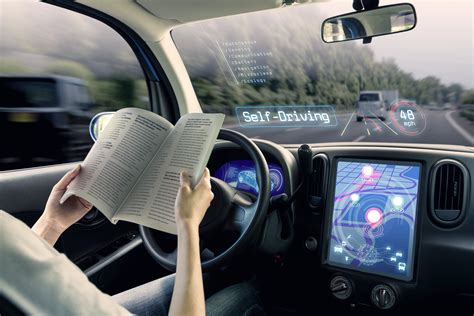AI is redefining the automobile sector, changing supply chain management, product marketing, production procedures, and road safety and vehicle interaction. More fascinating developments are anticipated in the automobile sector as AI advances.
With the advent of Autonomous Vehicles (AV) technology, the goal of a safe transportation system with effortless driving appears to be within reach. GM, Tesla, and Waymo are at the forefront of this movement. Their vehicles automatically follow traffic laws, park, and change lanes. Some even serve in some places as robo-taxis.

It is anticipated that the automation of systems will significantly reduce the number of accidents, as human errors contribute up to 90% of accidents. Self-driving cars are getting smarter. New tech helps them see and understand the world better. But are they getting safer?
How do self-driving cars work?
An autonomous car is a vehicle that operates without human assistance and can travel anywhere a conventional car would go. It uses sensors, actuators, algorithms, machine learning systems, and processors to operate.
Sensors like radar, video cameras, light detection, and ultrasonic sensors track other vehicles, pedestrians, road signs, traffic lights, and neighboring cars. The software then creates a route and instructs the vehicle’s actuators to manage steering, braking, and acceleration. Predictive modeling, object recognition, obstacle avoidance algorithms, and hard-coded regulations are also used to observe traffic laws and avoid obstacles.

According to the Society of Automotive Engineers (SAE), there are six stages of automated driving, from a fully autonomous car that runs entirely without human intervention to complete control by a physical driver equipped with cutting-edge safety technology. Starting at zero, the first three levels put the driver in charge of automated warnings or safety features. Self-driving technology is represented by Levels 3 and 4, albeit a human driver may still be needed. A completely autonomous vehicle is only deemed to be at Level 5 if it does not require a human to operate the controls.
Vehicles with limited hands-free systems like Ford’s BlueCruise, GM’s Super Cruise, and Tesla’s Full Self-Driving are rated Level 2. Mercedes-Benz introduced the first Level 3 system, Drive Pilot, in late 2023, but it is not considered “full self-driving” and is not marketed as such. As of early 2025, there are no fully self-driving cars available, not from Tesla or any other manufacturer.
How safe are self-driving cars?
In 2022, a report by Lloyd’s Register Foundation revealed that 65% of people worldwide would not feel safe driving without a human driver, despite the potential benefits of AI in reducing crashes. In every country where people were polled, the results showed that more participants would not feel safe in self-driving cars than the number who would.
Contrary to human concerns, a study published by the Nature Communications Journal analyzed accident data from 2,100 autonomous driving systems and 35,113 human-driven vehicles. Surprisingly, they found that self-driving cars had fewer accidents in most comparable accident situations.

They were, however, considerably more likely to be involved in a collision than human-driven vehicles in other situations, such as at dawn, dusk, and while the cars were turning. They were a startling five times more frequent in the dim light of morning and evening. Researchers hypothesized that these obvious discrepancies might result from a possible lack of situational awareness and the capacity to adapt to changing illumination conditions.
Fully autonomous driving is not yet ready for mainstream availability, but robotaxis are being developed and deployed in China and the U.S. However, safety concerns have arisen due to accidents involving pedestrians. In 2022, California had 1,552 autonomous vehicles registered for testing, driving 5.7 million miles. The crash rate for these vehicles was 96.7 per 1,000 vehicles and 26.3 per million vehicle miles, compared to 7.0 per 1,000 vehicles and 0.7 per million miles for the general vehicle population. National accident figures for all motor vehicles in the U.S. provide higher accident rates.
The increase in incidents involving self-driving cars is caused by a number of variables. One important contributing cause is the growing number of autonomous vehicles on the road, which inevitably raises the overall accident rate. The technology’s limitations are also quite important. Even with constant advancements, self-driving technology is still far from flawless. Accidents might result from sensor problems, software bugs, and the inability to understand complicated traffic scenarios.
The future of self-driving cars
As a result of consumers’ growing willingness to pay for technology-driven driving, automakers are expanding their offerings of automation and advanced driver-assistance systems (ADAS). By 2035, the passenger car market could produce between $300 billion and $400 billion thanks to ADAS and AD, according to McKinsey, a major management consulting group.
Less traffic accidents, fewer cars, automated logistics, better livability because of less air pollution and noise, and no parking or traffic charges will all have an impact on the world. The shift will be gradual, according to McKinsey, with only 4% of new passenger cars having level 3 or higher automation features in 2030, rising to 17% in 2035.

Reducing carbon emissions and encouraging sustainable living, autonomous technology can completely transform industries, work settings, and commuting. Regulating, reevaluating highway rules, influencing public opinion, enhancing infrastructure, and addressing culpability for traffic accidents are some of the major adjustments that must occur before this can become widely accepted. To do this, we need to deal with these issues and strive for a more sustainable future.




